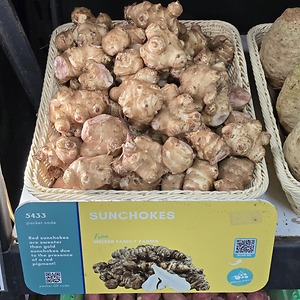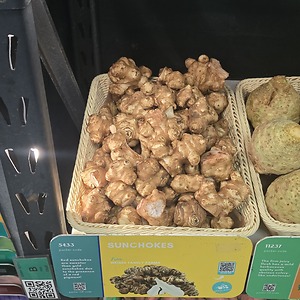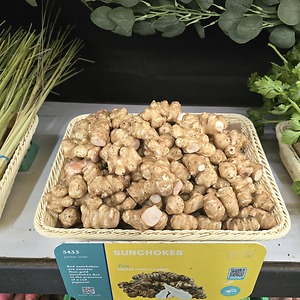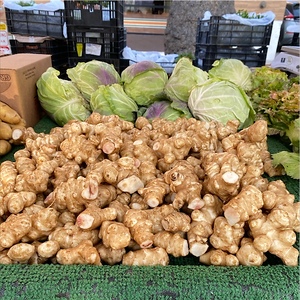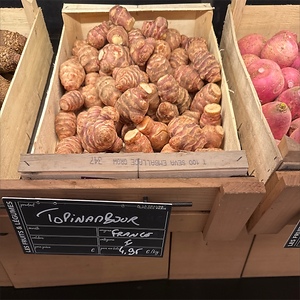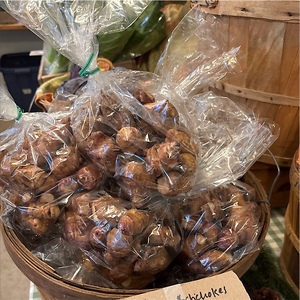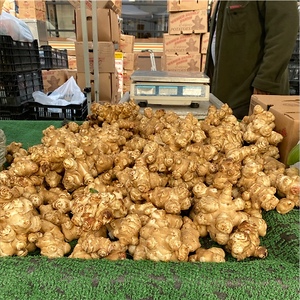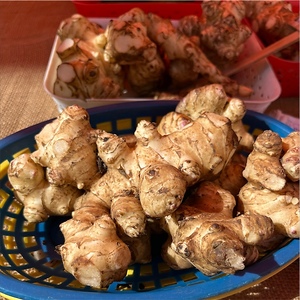


Sunchokes
Estimated Inventory, 20 lbs : 8.63
This item was last sold on : 07/17/25
Description/Taste
Sunchokes vary in size and appearance, depending on whether it is a wild or cultivated plant. Cultivated Sunchokes average 7.5 to 10 centimeters in length and generally have an oblong, round, or bulbous, knobbed shape. Wild Sunchokes are thinner, more elongated, and irregular in shape. Sunchokes have thin, semi-rough to smooth, textured skin and are covered in rings, knobs, and markings. The skin also ranges in color from beige, tan, light brown, to red. Underneath the surface, the white to ivory flesh is firm, dense, and snappy when raw, with a crisp, crunchy, and succulent consistency. The flesh has a texture similar to water chestnuts and will discolor relatively quickly after opening, but the color does not affect the tuber’s edibility. Sunchokes develop a soft, tender, and subtly chewy mouthfeel when cooked. Select fresh Sunchokes that are not dry or wrinkled for culinary preparations. The tubers are edible raw or cooked and have a delicate, sweet, and nutty taste with nuances reminiscent of sunflower seeds mixed with artichoke.
Seasons/Availability
Sunchokes are available year-round, with a peak season in the fall through early spring.
Current Facts
Sunchokes, botanically classified as Helianthus tuberosus, are the tubers of an herbaceous, perennial plant belonging to the Asteraceae family. The tubers develop from underground rhizomes and are foraged as a culinary delicacy. Above ground, the species produces upright green stalks, leaves, and seasonal yellow flowers reaching three meters in height, sometimes growing as tall as five meters. Sunchokes are native to North America and have been foraged as a food source from wild plants since ancient times. The species has also expanded worldwide and become a commercially cultivated crop, sold as an alternative to other root vegetables. Cultivated Sunchokes are distinct from wild Sunchokes as they typically grow just below the plant, are rounder, and bear white to tan skin. Wild Sunchokes are generally red-tinted, elongated, and can form over one meter away from the base of the plant. It is important to note that cultivated species have individual names, such as Stampede, Columbia, Mammoth, Oregon, LSD, Ordinaire, Red Fuseau, White Fuseau, and Clearwater, but these names are primarily reserved for home cultivation. In commercial markets, both wild and cultivated tubers are generally labeled as Sunchokes for ease of purchase. Worldwide, Sunchokes have acquired many general monikers, including Sunroot, Jerusalem Artichoke, Girasole, and Topinambour, and the tubers are favored by chefs for their versatility and mild flavoring. Sunchokes are edible raw or cooked and are incorporated into a wide array of sweet or savory culinary preparations.
Nutritional Value
Sunchokes contain inulin, a fiber and polysaccharide that is not digested or absorbed in the stomach. Inulin can sometimes help feed beneficial bacteria present in the large intestine, but this distinct process may cause gas and bowel discomfort in select individuals. Sunchokes also provide potassium, vitamins A, C, and K, magnesium, phosphorus, copper, and iron. Potassium replenishes electrolytes in the body and balances fluid levels, vitamin A maintains healthy organs, while vitamin C strengthens the immune system. Vitamin K assists the body in forming blood clots for faster wound healing, magnesium to control nerve functions, and phosphorus to support bones and teeth. Copper helps the body produce red blood cells, and iron develops the protein hemoglobin for oxygen transport through the bloodstream.
Applications
Sunchokes have a mild, delicate, sweet, and nutty taste suited for fresh and cooked preparations. The tubers can be served with or without their skin, depending on the variety and individual preference, and it is recommended to sprinkle cut portions with lemon juice or place them in an acidulated water bath to prevent the surface from discoloring. Once prepped, Sunchokes can be sliced and added raw to salads, served on crudité plates, or chopped into salsa, dips, and relishes. Sunchokes can also be pickled as a tangy condiment or blended into marinades and various sauces. In addition to fresh preparations, Sunchokes are versatile in cooked dishes and are used as a substitute for water chestnuts, potatoes, or jicama in recipes. The tubers are roasted as a simple side dish, boiled and mashed, baked into strips, or cooked in gratins. Sunchokes are also incorporated into soups and stews, added to stir-fries, or combined with other root vegetables as a side to meat main dishes. Beyond whole uses, Sunchokes are dried and ground into a powder for pasta, bread, soups, and pancakes. Sunchokes pair well with herbs such as thyme, sage, mint, and oregano, watercress, tomatoes, beets, mushrooms, cream, garlic, and meats, including lamb, poultry, beef, and fish. Whole, unwashed Sunchokes should be wrapped in paper towels and stored in a sealed container in the refrigerator, where they will last for 1 to 2 weeks. Cooked Sunchokes should be kept in the refrigerator and used within a few days.
Ethnic/Cultural Info
Sunchokes have acquired several names throughout their history. One of the first names for the species is the Algonquian word “Kaishucpenauk,” a language spoken by Indigenous people groups in central and eastern North America. This name is said to roughly be a combination of the words for “sun” and tuber.” In the 17th century, when explorer Samuel Champlain encountered the tubers, he named them Canadian Truffles, “Pommes de terre du Canada,” or Canadian potatoes, and “Artichauts de Canada,” meaning Canadian artichokes. After the species’ introduction into France, the tubers were called Poires de Terre or “Earth pears” and were later named Topinambours after a curious overlap with the arrival of a Brazilian indigenous people group in France. In 1613, six members of the Tupinambá indigenous people group in Brazil were brought to Paris. As crowds gathered to view the tribe members, street vendors began selling the newly introduced Helianthus tuberosus tubers under the name Topinambours or Topinambous to increase sales and profit off the excitement of the Brazilian slaves. In Italy, the species was called Girasole, a name given for flowers that follow the sun, and eventually became known as Girasole Articiocco, meaning “Artichoke sunflower.” It is unknown how the name Girasole Articiocco eventually became corrupted to Jerusalem Artichoke, but the name stuck and is widely known under this moniker in English-speaking markets worldwide. In 1918, the species was renamed Sunroot from an English naming contest and was also branded under the Sunchoke name in 1965 in Los Angeles, California.
Geography/History
Sunchokes, or Helianthus tuberosus, are native to North America and have been growing wild since ancient times. The species is thought to have origins in the central regions of North America, mainly between the United States and Canada, east of the Rocky Mountains. Over time, Helianthus tuberosus expanded in cultivation across North America, spreading south into Mexico through indigenous North American tribes who foraged the tubers as a food source. In the early 17th century, French explorer Samuel de Champlain encountered the edible tubers in coastal Massachusetts and recorded the first written description of the species in 1605. Champlain noted in his writing that the tubers tasted like artichokes and were being cultivated by the Abenaki indigenous community of the region. He mentioned the species in a few other records throughout the areas he explored in Massachusetts. In 1607, it was believed that Champlain and his travel companion, author Marc Lescarbot, carried Helianthus tuberosus tubers to France and introduced them as a new crop. The initial tubers planted in France were hypothesized to be of the wild, red-skinned cultivars. Sometime between 1613 and 1616, the tubers gained recognition within French markets and were planted as a new popular root vegetable. Throughout the rest of the 17th century, Helianthus tuberosus became a favored ingredient in French cuisine until the introduction of potatoes. In 1805, American explorers Lewis and Clark notably encountered the species through North American indigenous people groups in North Dakota. Helianthus tuberosus also became an extensively grown species during World War II in home gardens in the United States and France as food rationing was instated, but later fluctuated in popularity and obscurity with changing consumer preferences and market uses. In 1965, Frieda Caplan of Frieda’s Produce in Southern California noticed the tubers being sold in the Los Angeles Produce Market and rebranded the tubers under the name Sunchokes for increased consumer appeal. Today, Sunchokes are still found growing wild throughout the United States, Canada, and Northern Mexico. The species is also commercially cultivated and grown in home gardens in North America and parts of Europe, mainly in France. When in season, Sunchoke tubers are sold through local markets, select retailers, and distributors as culinary ingredients.
Featured Restaurants
Restaurants currently purchasing this product as an ingredient for their menu.
| Barra Oliba | San Diego CA | 610-310-5110 |
| Elvira | San Diego CA | 619-560-3800 |
| Rancho Bernardo Inn | San Diego CA | 877-517-9340 |
| Trust Restaurant | San Diego CA | 609-780-7572 |
| Baja Cavi | Lomas de Valle Verde 22810 | 619-295-3172 |
| Georges at the Cove | San Diego CA | 858-454-4244 |
| Campo Gourmet | San Diego | 619-719-6924 |
| Javier Plascencia (Animalon) | Bonita CA | 619-295-3172 |
| Mister A's | San Diego CA | 619-239-1377 |
| Huntress | San Diego CA | 619-955-5750 |
| Miguel Angel Mendoza | Maestros Ensenada, | 646-127-0277 |
| Lauberge Del Mar | Del Mar CA | 858-259-1515 |
| Herb & Sea | Encinitas CA | 858-587-6601 |
| Little Frenchie | Coronado CA | 619-522-6890 |
| InterContinental Vistal Kitchen | San Diego CA | 619-501-9400 |
| Campfire | Carlsbad CA | 760-637-5121 |
| C 2 C | San Diego CA | 619-972-9345 |
| Vulture / Dreamboat | San Diego CA | 858-342-3609 |
| UCSD Food & Nutrition Department Hillcrest | San Diego CA | 619-380-9840 |
| Jeune Et Jolie | Carlsbad CA | 858-231-0862 |
| UCSD Health East campus | San Diego CA | 619-578-3373 |
| Kettner Exchange | San Diego CA | 909-915-9877 |
| Herb & Wood | San Diego CA | 520-205-1288 |
Recipe Ideas
Recipes that include Sunchokes. One



